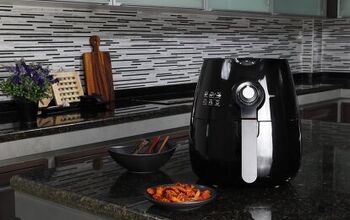Can You Put An Electric Skillet In The Dishwasher? (Find Out Now!)

Electric skillets are handy gadgets in the kitchen. Versatility is the name of the game with modern electric skillets. No longer just for frying, many new electric skillets allow you to pan fry, sauté, deep fry, or steam foods easily and quickly. However, many cooks wonder if they can put their electric skillet in the dishwasher.
Only the manufacturer of your electric skillet can tell you whether it is dishwasher safe. Many new electric skillets feature removable cooking surfaces or have sealed heating elements that are dishwasher safe. You should follow the manufacturer’s recommendations on putting your electric skillet in the dishwasher.
Cooking with an electric skillet on your countertop can be an efficient and effective way to prepare meals for your family. The versatility of new electric skillets makes them handy kitchen appliances. Understanding how best to use and care for your electric skillet can add to your enjoyment of this appliance. Read on to learn more.
Do You Need a Maid Service?
Get free, zero-commitment quotes from pro contractors near you.

Electric Skillets Explained
An electric skillet is aptly named. This countertop appliance features a cooking service much like a regular skillet used on a stovetop. An electric heating element built into the skillet frame provides the heat for cooking without resorting to the burners on your cooktop. This can free up your cook stove for other duties.
Most electric skillets have a thermostatic control that plugs into the skillet frame to control the skillet’s temperature. Like the controls on your cook stove, you can select the cooking temperature in the pan on the thermostatic control.
Electric skillets are routinely used for various kitchen chores such as pan-frying, sauteing, deep-frying, and warming foods. The shape of the cooking surface varies, offering a choice of designs and styles from rectangular to round and various depths.
Options and Features of Electric Skillets
You can find a wealth of options and features on electric skillets that make them useful in the kitchen. If you are shopping for an electric skillet, these are some of the features and options you may want to consider.
Non-Stick Coatings
Most new electric skillets feature some non-stick coating on the cooking surface. Non-stick coatings can make using your electric skillet easier and more enjoyable. Cleanup times are usually cut significantly on electric skillets that include a non-stick coating. Food tends not to burn as readily. Even when sauteing, the pan stays free of buildup caused by sticking food.
However, non-stick coatings can be scratched, rendering them less useful. Care must be taken in handling, storing, and cleaning non-stick surfaces to avoid damage.
Size, Shape, and Depth
Electric skillets are available in a wide variety of sizes and shapes. Different sizes and shapes often work better for different functions. You should consider how you anticipate using your electric skillet before you buy it. In general, you should consider these options when selecting the size and shape of an electric skillet.
- Size – Electric skillets are available in sizes ranging from 10 inches to 16 inches. The optimum size for your kitchen depends on what foods you intend to cook. The size of the portions is also important. Larger families usually require a larger electric skillet. Lastly, don’t forget about storing your electric skillet. You will need ample storage space unless you plan to keep the electric skillet on the countertop all the time.
- Shape – What you intend to cook also dictates the best shape. Electric skillets come as round, rectangular, or oval pans. Many cooks prefer a standard round electric skillet because it is familiar. Others find a larger rectangular skillet more adaptable. The shape is a personal choice that should be considered when shopping for an electric skillet.
- Depth – The depth of the cooking pan can increase the number of uses you find for your electric skillet. Shallower pans may be more convenient for pan-frying or sauteing. Deeper pans may be a better choice for deep frying or steaming foods.
Non-Stick Coatings
All new electric skillets come with some non-stick coating on the cooking surface. You can find a few stainless steel electric skillets with no coating. These stainless steel skillets are still preferred by many cooks. In any case, it is important to understand non-stick coatings before you buy.
- Ceramic coatings came onto the kitchen scene in the 1960s and were all the rage. These new coatings offered a choice to the PTFE coatings currently in use. The materials used to make ceramic non-stick coatings are all-natural and no-toxic. However, ceramic coatings are not as durable as other types of non-stick coatings.
- PTFE (polytetrafluoroethylene) is more commonly known by the tradename Teflon™. It is not a space-age material like many people think. PTFE was discovered in 1938. The slippery surface of PTFE, when applied to cookware, began the non-stick cooking era. PTFE should be used only for low-temperature cooking to avoid releasing toxic fumes. You should avoid cooking at temperatures over 260 degrees when using PTFE cookware.
- Silicone coatings have become more popular. Silicone is a natural product produced from silica and applied to cookware surfaces. Silicone-coated cookware should be kept below 300 degrees to avoid damaging the coating. The FDA currently lists silicone as an acceptable food-grade non-stick coating.
- Enamel-coated cast iron is a long-time favorite for many cooks. The enameled coating over a cast iron pan gives excellent heat distribution and provides a smooth cooking surface that resists ticking. An enamel surface is a form of glass. The glass coating can be fragile and easily chipped. This is the most expensive type of non-stick cookware coating.
There are other types of non-stick coatings, but they are usually not used on electric skillets. We recommend that you select an electric skillet with a non-stick coating to make cleanup easier in the kitchen.
Thermostats and Temperature Control
Many lower-end electric skillets feature temperature controls that offer only a few settings. These electric skillet controls usually include only low, medium, and high settings. This can make cooking with these electric skillets a challenge.
A better alternative is to select an electric skillet with a variable temper control and a thermostatic option. These controls allow you to choose a cooking temperature, and the electric skillet will stay within a narrow range of that temperature. These controls give you more precise temperatures and better control of your cooking. They are well worth the few extra dollars.
Do You Need a Maid Service?
Get free, zero-commitment quotes from pro contractors near you.

Picking Your Electric Skillet
No matter which electric skillet you decide is right for your kitchen, make sure that the manufacturer labels it as dishwasher safe. You must also follow the manufacturer’s directions to put your electric skillet through the dishwasher safely. A dishwasher-safe electric skillet can make cooking more pleasurable and more efficient.

Dennis is a retired firefighter with an extensive background in construction, home improvement, and remodeling. He worked in the trades part-time while serving as an active firefighter. On his retirement, he started a remodeling and home repair business, which he ran for several years.
More by Dennis Howard



























